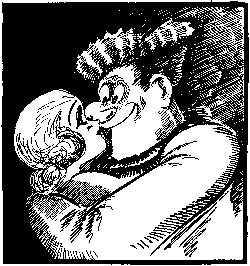By 1930, “the funny pages” were no longer a novelty in America’s newspapers. Though for the most part still fresh, innocent, and blissfully free of pretension, comic art was beginning to attract “serious” critics. And when serious critics are available, “serious” artists start producing “serious” work for their delectation. Inspired by an experimental Belgian expressionist’s attempt to tell a story entirely in pictures, an American named Lynd Ward tried his hand at the form. God’s Man, which appeared in 1929, was a tale of aspiration, temptation, and corruption rendered in moody woodcuts. It wasn’t much fun, but it was taken very seriously.
By everyone but Milt Gross. Gross had been filling the comic pages with one-shot gags, two-panel ticklers, and Yiddish- dialect anecdotes for 15 years when Ward’s book came out, and his response to its reverent reception was to dash off his own wordless narrative, He Done Her Wrong, modestly subtitled The Great American Novel (With No Words). There was nothing novel in Gross’ plot material: Virginal maiden is stolen from innocent lumberjack by snaky mustachioed villain. What make it come to life is Gross’ incredibly expressive pen-and-ink drawing, which looks almost childishly slapdash but generates cascade after cascade of chuckles as the hackneyed narrative hurtles on.
Gross never was a critical darling like the rococo Winsor McCay (Little Nemo in Slumberland) or the proto-absurdist George Harriman (Krazy Kat), but he was a far better storyteller than either, and the sheer speed of his narrative has never been equaled in comic art. And to my way of thinking, he was a greater artist: not stuck in any one “look” but, like a master impressionist, able to make his scrawly pen nib suggest a multitude of styles.
Fantagraphics has produced the first unabridged reprint of He Done Her Wrong since its 1930 publication. For aficionados of “the graphic novel,” it’s a must-have; it’s even more essential reading for aspiring cartoonists, who can learn from its pages just how little ink and how much imagination it takes to create an unforgettable little world.








